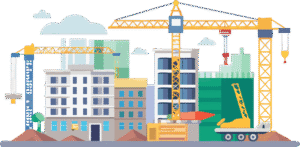The lack of land availability in high-density cities is posing a challenge for developers trying to break ground on new projects and address urgent housing needs. Now, right-of-way agreements, or the developer’s right to build, sell, or lease the space below or above a property, are getting more attention as a way to circumvent land acquisition challenges. In particular, air rights. or property owner’s right to the vertical space extending above a property, are becoming an increasingly popular method for spurring housing development in high-density markets. Air rights present a two-fold opportunity for developers – building vertically over transit hubs, freeways, or other untapped space, and taking advantage of untapped development rights for landmarked buildings to increase density and scale of projects.
Here’s everything you need to know about taking advantage of air rights opportunities, and the challenges and benefits for development teams:
Understanding Air Rights in Real Estate
Air rights, or a developer’s legal use to use or sell the space above a property, are a growing interest for developers looking to expand properties and address housing needs in high-density markets. The concept of air rights has been around for generations, but evolved alongside the invention of aviation and urban zoning laws. Before the Federal Aviation Act gave the federal government the ability to regulate U.S. airspace, property owners held unlimited rights to the air above land. However, even with public easement, developers have jurisdiction over the air above a property, and building upward is becoming an increasingly attractive option in high-density cities.
In major cities where access to land is complicating new builds, air rights are enabling major projects. Hudson Yards in New York City, the largest mixed-use development project in the United States, was enabled by air rights. The Metropolitan Transit Authority owns the rights over Hudson Yards and gave a 99 year lease through Transferable Development Rights (TDR) zoning policy to enable developers to pursue the project, which includes 16 new buildings, 4,000 apartments, a school, parks, and office space. Developers in Boston are also turning to air rights with plans to build a major deck building over the Massachusetts Turnpike near Fenway Center, creating more neighborhood connectivity and addressing housing needs.
How Air Rights Create Unique Opportunities
As crowded cities struggle to find new land sites to build on, air rights are being used more and more to unlock equity and find new development potential. Many of the air rights projects breaking ground today are transit-oriented, built over railway hubs or major freeways. Building transit-oriented developments can have additional benefits for your development team, opening access to funding in the form of grants or tax incenrtives and making the property more desirable to potential tenants.
Developers can also take advantage of public-private partnerships when building over transit, stations, railyards or highways, turning underutilized areas of cities and transforming them into high–value real estate that revitalizes infrastructure. Air rights also encourage architectural innovation and experimentation, and many of the projects breaking ground in the last decade have become visually striking and structurally ambitious. Many air rights projects in recent years, such as Hudson Yards, Parcel 12, and One57, are transforming communities and defining skylines.
Even for developers who aren’t looking to build in space above transit hubs, air rights can unlock zoning potential for vertical builds. In cities with transferrable development rights (TDRs), developers can buy unused air rights from adjacent properties to increase building height and density. When developers buy difficult to redevelop heritage buildings in certain markets, the rights can be banked and used to scale up properties in other locations. It’s becoming increasingly common for developers to use air rights to fund preservation. Selling air rights in these scenarios can be a win-win for developers – helping safeguard historical properties and promote vertical development in major cities.
Challenges and Considerations
Even though air rights are presenting new and exciting opportunities for urban development, the strategy is not without its challenges. Zoning laws and community resistance are two of the most common obstacles you’ll face when taking advantage of air rights. Governments and community members express concerns about over densification of cities, citing concerns projects won’t address community needs or improve quality of life. Projects taking advantage of air rights opportunities often require coordination and approvals from governments, local planning boards, and other stakeholders. However, residents tend to be more amenable to vertical development, and governments are loosening zoning restrictions in many communities to boost housing production. By incorporating social responsibility and thoughtful urban planning into air rights agreements, developers can take full advantage of opportunities without compromising the character of involved communities. To incorporate communities into the air rights process, consider incorporating public dialogue and community input. Prioritizing community engagement and street-level connectivity can prevent air-rights projects from feeling oversized or disconnected from the communities in.
Legal issues can also sometimes arise due to air rights evocation. Potential disputes that may arise for developers include conflict over obstructed views, disagreements over shared areas for multi-tenant buildings or over public space, negotiations regarding air rights acquisitions for expansions. Since the value of air space is less easily quantifiable than a parcel of land, negotiations around fair market value for the air rights may take longer and have less defined terms .Developers should be conscious to resolve any potential boundary disputes or other legal issues early to prevent project delays.
Future of Air Rights in Real Estate Development
Utilizing air rights has numerous benefits for developers, and many ambitious, city-defining mixed-use development projects have been enabled using the strategy. Developers will find air rights enabled projects align with sustainability goals, reducing sprawl and aligning with transit-oriented development principles. In addition, transferable development rights allow teams to parcel together rights, leading to higher-density, more ambitious projects. For cities struggling to address housing crises, both government agencies and urban planning stakeholders are likely to be more amenable to air rights enabled projects.
Looking toward the future, high-land costs, rising construction fees, zoning challenges, and will make air rights utilization an even more attractive strategy. Development teams looking to take advantage of air rights opportunities can leverage technology to facilitate the lifecycle from predevelopment through stabilization. Modern real estate development software can also play a role in how your team goes about air rights utilization. Projects enabled by air rights require many stakeholders to be involved — local governments, transit authorities, neighboring property owners, or investors. Many development teams struggle to get visibility on key data and benchmarks in terms of schedules, compliance documentation, and budgets. Northspyre standardizes and automates document management, empowering your development team to collaborate and communicate more effectively.
Book a Demo today and learn more about how Northspyre helps deliver more predictable outcomes on your complex development projects.



